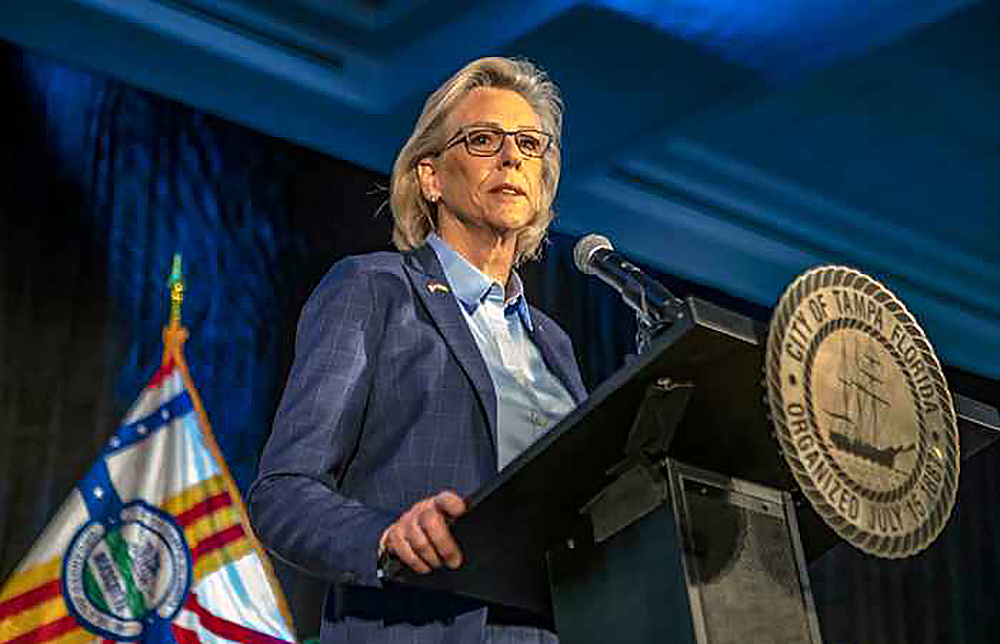
Tampa Mayor Jane Castor will deliver her annual State of the City Address Monday morning at 11 a.m., broadcast on the city’s YouTube and Facebook channels.
This will be Castor’s sixth State of the City Address, and the second of her final term in office, as some are already looking toward the 2027 race to succeed her.
The address also comes as the region faces ongoing recovery from back-to-back hurricanes in 2024, and as affordability issues continue to plague residents.
The speech is an opportunity for Castor to acknowledge pain, explain what she and other city leaders are doing to address it, and showcase Tampa as a city on the move despite its challenges.
Here are some topics to listen for in the Mayor’s address:
Infrastructure
Nothing calls attention to infrastructure problems more than severe weather events. Water and drainage systems are tested. Never in recent memory has Tampa been challenged the way it was in 2024 after Hurricanes Helene and Milton.
The city successfully cleared debris ahead of schedule, a testament to a quality public works team.
And work continues. Low lying areas, such as Davis Islands, parts of the Westshore area and Palmetto Beach, are still rebuilding from devastation driven largely by flooding. The city under Castor established a disaster assistance fund that she has an opportunity to tout.
But that recovery continues just over a month away from the next hurricane season, which is projected to again be active. While Castor can’t, as some may suggest, control the weather, she has worked throughout her two terms as Mayor to improve the city’s aging infrastructure. That’s an issue that plagues not just Tampa, but also neighboring St. Petersburg, where leaders are trying, but struggling, to keep up with demand.
In Tampa, Castor’s administration has invested big in infrastructure. She’d be wise to dive into the specifics of those investments, including the city’s largest public works project ever, PIPES. It’s a $2.9 billion funding plan approved in late 2019 that gradually increases water and wastewater rates over 20 years to bring the city’s infrastructure in line with current needs. Rates hadn’t been increased in the city for a decade prior to the passage of the PIPES program.
All of this is an opportunity to applaud devoted city staff and to remind residents who are still suffering, as well as those fearful for the next hurricane season, that city leaders and an army of rank-and-file civil servants are still there and understand their pain and anxiety over what a next storm could hold.
She can also promise them public safety.
Tampa first responders yielded thousands of calls during both Hurricane Helene and Milton and, during Milton, rescued more than a dozen people who were trapped in a home that was crushed by a tree. They also successfully evacuated more than 135 seniors from an assisted living facility that flooded.
The immediate response, particularly from a public safety standpoint, is an opportunity to put residents’ minds at some ease knowing first responders are trained and experienced for these sorts of rescues.
Transportation
A huge headache for residents who must navigate it every day, for workers who commute into the city from elsewhere and for tourists visiting the area, transportation problems and omnipresent congestion remain one of the most visible and tangible frustrations in Tampa.
Common bottlenecks around the West Shore area, downtown and the Interstate 4 interchange are clogged almost any time of day, any day of the week.
Castor cannot hide from this reality, and no shade of rose-colored glasses will convince anyone who has had to navigate Malfunction Junction at rush hour, which now feels like any hour, that the problem is getting better.
But acknowledgment goes a long way, and it’s an opportunity to remind that the progress voters had asked for in the All for Transportation package was axed by the courts. Castor should remind her constituents that despite the setback, the city is doing its part.
That includes expanding the Streetcar and ongoing improvements under the city’s Mobility, Opportunity, Vision, Equity and Safety (MOVES) program continue, including strategic transit projects, new trails and greenways, efforts to eradicate pedestrian fatalities and more.
Affordable housing
Residents continue to face an affordability crisis. But Tampa is not alone in that challenge; it’s happening everywhere. Like others facing this crisis, Tampa has worked to increase housing supply to meet demand and, in doing so, drive prices down.
The city has used modern solutions, such as zoning changes, to bring more accessory dwelling units online and helping with down payments and rent payments.
It is often the case that when wallets get light, voices get loud. So affordability will remain a thorn in any administration’s side, and everyone has different ideas on how best to address the situation. Castor has an opportunity to remind that all reasonable solutions are on the table, and that help continues to be on the way.
The state of the city is strong
That’s always the takeaway in any state of the city, state of the state or state of the union address. It’s an expected applause line.
But it is perhaps more important now than ever to tout Tampa as the growing destination for live, work and play that it has become. Here, some of the city’s greatest challenges also serve as evidence of its success.
Transportation is bad because people keep coming here. Affordable housing is limited because supply is having trouble keeping up with demand. Yet despite the challenges success creates, people still keep coming, spotlighting Tampa as one of America’s great cities.
And Tampa continues to improve as what Castor has described as the Tampa of tomorrow. She continued work on the popular Riverwalk, and has overseen countless neighborhood revitalization projects that turn blight into a destination, including GasWorx, Water Street, the Midtown project and more.
She may only be about halfway through her final term, but the things she does now will contribute to how her legacy is shaped. The State of the City address is an opportunity to write her own narrative, but also to inspire a community in desperate need of inspiration.



